#fossil identification
Explore tagged Tumblr posts
Text

Hope this rock is some part of an coral fossil.
Like an first found myself an rugosa coral.
Thanks guys for inform telling me.
9 notes
·
View notes
Text


So to beginn the first speciemen of fossil for this post. Found today, not seen found before.
Likely some sort of porifea = sponge.
An with tiny silicat veins Astylospongia praemorsa.
After learning the name i got good reference pictures of it. My first find of this specimen!!
Findings of known deposits from astylospongia are in my area from belgium to middle germany poland to the baltic sea and goes up to north.
Brown like chert- flint near round bulb alike. Complete round underside without stem or breaks. Looking like an dry old fig fruit. 🤨
In wet condition its darker gray, with silica vein like struckture like some sponges have. Chestnut sized.
I leave the rugosa + horn coral species Id image here for the future, to lose quick compare.
# Ordovician sponge Astylospongia praemorsa
Prepare some warning for annoying ads from the Researchgate site of the article on the link.
#fossils#geology#fossil hunt#fossil collecting#fossil identification#fossil#fossil id#fossils in germany#fossils 2024#fossil friday
16 notes
·
View notes
Photo

Nummulites laengryus Fossil - Bracklesham Beds, Eocene - Bracklesham Bay, Sussex, UK - Genuine with COA
Nummulites laengryus Fossil - Bracklesham Beds, Eocene - Bracklesham Bay, Sussex, UK
This is a genuine fossil specimen of Nummulites laengryus, a species of Foraminifera, sourced from the Bracklesham Beds, Eocene period, Bracklesham Bay, Sussex, UK. Nummulites are single-celled marine organisms with distinctive, disk-shaped calcareous shells, which accumulated over millions of years to form vast limestone deposits. These fascinating microfossils played a crucial role in shaping ancient marine ecosystems and are of significant scientific interest.
Geological Information:
Species: Nummulites laengryus
Fossil Type: Foraminifera (Single-celled Marine Protist)
Age: Eocene (~56 to 33.9 million years ago)
Formation: Bracklesham Beds
Location: Bracklesham Bay, Sussex, UK
Preservation: Fossilized calcite shells embedded in sedimentary rock
About Nummulites: Nummulites are a type of foraminifera, microscopic marine protozoans that produce multi-chambered shells. These organisms thrived in warm, shallow seas and their abundant remains helped form limestone deposits, particularly in regions like the Bracklesham Beds and the famous Eocene Nummulitic Limestone of the Mediterranean.
Fossils of Nummulites provide valuable insights into paleoclimates, ancient marine ecosystems, and biostratigraphy, helping geologists date sedimentary rock layers.
Key Features:
100% genuine fossil specimen of Nummulites laengryus
Comes with a Certificate of Authenticity
Well-preserved fossil with visible spiral structure and calcite shell details
Sourced from the Bracklesham Beds, Eocene, a renowned fossiliferous site in the UK
A fascinating piece of geological and paleontological history
Ideal for collectors, geologists, paleontologists, and educators
Handling & Care:
Fragile Specimen: Handle with care to preserve its delicate structure.
Keep Dry: Store in a dry environment to prevent deterioration.
Cleaning Tip: Use a soft brush to remove any dust or debris. Avoid harsh chemicals or moisture exposure.
Additional Information:
The photos show the actual specimen you will receive, ensuring transparency and authenticity.
Scale cube = 1cm; for full sizing, please refer to the images provided.
Expertly packed for safe and secure shipping.
This Nummulites laengryus Fossil is a rare and scientifically significant specimen, perfect for anyone passionate about fossils, ancient marine life, or natural history. Buy with confidence, knowing you are receiving a 100% authentic fossil, backed by our Certificate of Authenticity.
🛒 Add this remarkable Nummulites Fossil to your collection today!
#Nummulites Fossil#Foraminifera Fossil#Eocene Fossil#Bracklesham Bay Fossil#Sussex Fossils#Bracklesham Beds#UK Fossils#Microfossil#Fossilized Shell#Paleozoic Fossil#Fossil Collector#Geological Specimen#Authentic Fossil#Ancient Marine Life#Fossil Identification#Rare Fossil#Scientific Fossil#Fossil Display#Natural History Collectible
0 notes
Text
Anyone here good at IDing fossils?
0 notes
Text
science side of tumblr!!!


anyone know what this rock is?? i can't figure out from research what it might be/what formed it this way.
will send more pictures/answer more questions if needed 👍👍
even if you don't know i'd be really appreciative if you reblogged so i cna try to get this solved :D
#science#science side of tumblr#scienceblr#geology#rock#rocks#rock id#rock identification#i just picked it up out of a big rock section outside our physics building#and then was like ???#what is that#so if anyone knows please help!!#i have gone through that thread on the lumpy rock#not convinced its fish egg fossils but others please chime in
16 notes
·
View notes
Text





I’ve handled a lot of Indiana river rock recently. These are a few I saved. I have a life long fascination with geology, Indiana has much to explore. The last two rocks give me comfort when I hold them. I don’t know why but I aim to find out!
#rocks#river rocks#fossils#geology#rock identification#metamorphic#from a long time ago#meditative#healing
9 notes
·
View notes
Text
I only have 130 followers on this blog and obviously that's not a lot but I just looked at that number and thought "wait, that's enough to fill three of the classroom I normally teach in, and they're all reading my posts, what the fuck"
#suchobabbles#more people listen to me talk about my love-hate relationship with ensemble stars than listen to me explain fossil identification#haha just kidding i know only five of you actually read my posts
1 note
·
View note
Text

Bring us your good stuff! Monday, November 6th from 5-7 is our next public ID night. Bring your rocks, minerals, and fossils that you need identified and let us help you figure it out. We'll also have some information on 'Sinkholes and Caves in the Chattanooga area'. Enter through the open, gray double doors next to parking lot 10 where parking is free after 5:00. We hope to see you!" -
UTC Geology: The Geology Division in the Department of Biology, Geology and Environmental Science
#UTC Geology#University of Tennessee Chattanooga#Department of Biology#Rock#Mineral#Fossil#Identification#Rock Mineral Fossil Identification#Sinkholes And Caves In The Chattanooga Area
0 notes
Text
so when i play a game in a series sometimes i’ll go back and play the first game (even if there isn’t a narrative) to see how much the core gameplay has changed and this is how i found out that in Animal Crossing for the gamecube Blathers isn’t fossil identification certified. i grew up on Wild World where not only could he but he LOVED to identify fossils and assumed it had always been the case, but no, in the first generation of animal crossing games you have to fucking mail you fossils to another museum who identifies them for you and then sends them back three at a time. wild. it feels like a flashback set in the 80s or something
97 notes
·
View notes
Text
Wet Beast Wednesday: whale shark
So I may have committed a cardinal sin last week because I didn't realize it was shark week and instead of a shark, I covered hagfish. This was clearly a terrible oversight and to make up for it, I'm going to talk about the biggest shark of all: the mighty whale shark.

(Image: a whale shark seen from the side. It is a very large shark with a flattened head and three ridges running down its side. The skin in grey and covered in white spots. Smaller sharks and remoras are swimming alongside it. End ID)
Whale sharks (Rhincodon typus) are carpet sharks, meaning they are members of the order Orectolobiformes. The carpet sharks most people are familiar with are the wobbegongs, who are ventrally flattened sharks they typically stick near the seafloor, but Orectolobiformes is a pretty diverse clade containing a large variety of sharks with diverse body plans. Whale sharks are the only living member of the family Rhinocodontidae, making them effectively cousins of the wobbegongs. While there is only one living species of whale shark, we know of another few in the fossil record and there were likely more extinct species and relatives that we don't know about. Because shark skeletons are made of cartilage, they rarely fossilize, leaving only their teeth as fossils. Whale sharks have very tiny teeth and smaller things are less likely to fossilize than large things. Add in that fossilization is very rare and it's very possible there were whale sharks and other similar things in the past we will never know about because they never fossilized.
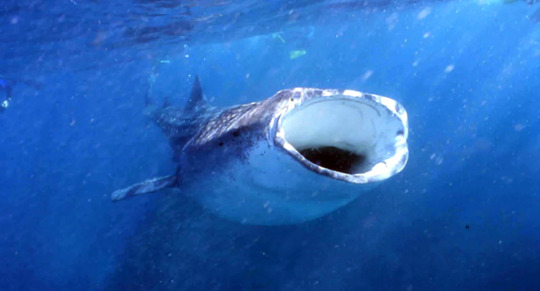
(Image: a whale shark seen from the front. Its mouth is open, very wide, and apparently toothless. End ID)
Whale sharks are the largest living sharks and the largest living animals that aren't whales. Whale sharks can reach an average adult size of 14.5 meters (48 ft) and 18,600 kg (41,000 lbs), with males being larger. The largest whale shark on record was measured to be 18.8 m (62 ft). Whale sharks have broad, flattened heads and unlike most sharks, their mouths are on the front of the head instead of beneath the snout. The mouth can be over 2 meters across in an adult and is lined with approximately 300 rows of tiny teeth. These teeth are vestigial and do not play a role in feeding. Instead, the shark uses a structure at the back of the mouth composed of 20 fleshy pads that are coated with a thin mesh and held in place with connective tissue. More on feeding below. Whale sharks are grey in color, with white bellies and white spots covering the body. Each whale shark has a unique pattern of spots that scientists can use for identification. The spots will reappear in areas where damaged skin has healed instead of being scarred over. Whale sharks also have some regenerative ability, being able to recover from major wounds and possibly regrow sections of lost fin. Each side of the body has three long ridges that may help with streamlining.
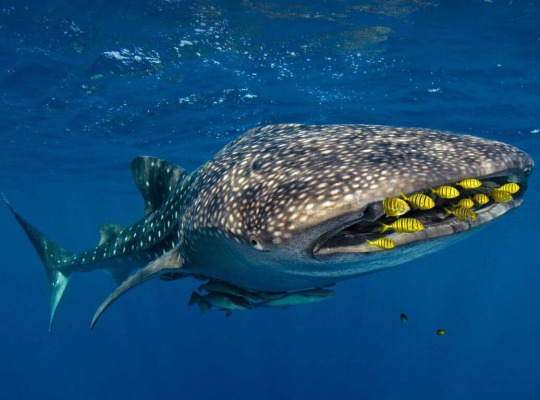
(Image: a whale shark seen form the front with its mouth closed. There are remoras attached to its underbelly and a group of small yellow fish with black stripes swimming near the mouth, possibly acting as cleaner fish. End ID)
Whale shark skin can be up to 15 cm thick and is covered with tiny, tooth-like scales called dermal denticles. Having tiny teeth where bony fish have scales is normal for sharks. What is not normal is having them on your eyes, but the whale shark does anyway. Let me repeat: whale sharks have teeth on their eyeballs. I like body horror and I'm creeped out by that. The eyes can be retracted into the head and these two adaptations are believed to protect the eyes from predators and parasites. Another adaptations the eyes (which, again, HAVE TEETH ON THEM) have is a mutated version of rhodopsin, the pigment the rod sells of the yes use to see. this mutation makes the eyes good at seeing blue light, but the rhodopsin becomes unstable in warm temperatures. In humans, this mutation leads to a degenerative eye condition that can result in blindness. Whale sharks have a solution, though. When in warm, shallow water, the pigment can be turned off to keep the eyes from degenerating. When the shark dives to deep water, the pigment is reactivated, granting the shark better vision as blue light is the most common in the deep sea.
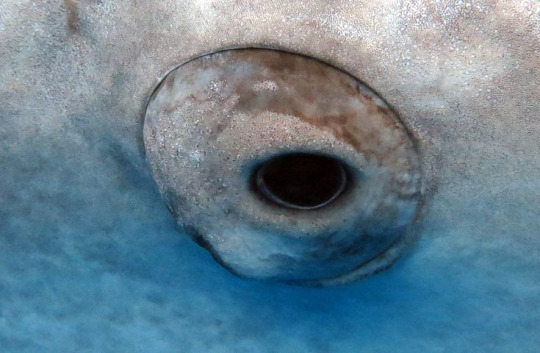
(Image: a close-up of a whale shark eye. It is a small, black, lidless eyeball surrounded by gray skin. End ID)
While whale sharks are huge, they aren't hunters. They are one of three living species of filter-feeding shark, the others being the basking shark (which I covered previously) and the awesomely-named megamouth shark. The majority of a whale shark's diet consists of plankton: primarily copepods, krill, eggs and larvae, and small fish, squid, and jellyfish. The shark can feed either by ram feeding (swimming forward with the mouth open) or creating suction to draw water into the mouth. The mouth is shaped like a funnel and forces water through the filtration pads. The pads, which likely evolved from gill rakers, capture food particles, which are then swallowed as the water is forced out through the gills. The filtration pads are extremely efficient and resistant to being clogged up with debris, though whale sharks have been observed performing a coughing-like behavior that is speculated to help clean the pads. Whale sharks spend up to 8 hours a day near the surface of the ocean, feeding on an estimated 2.7 kg (6 lbs) of plankton per hour.
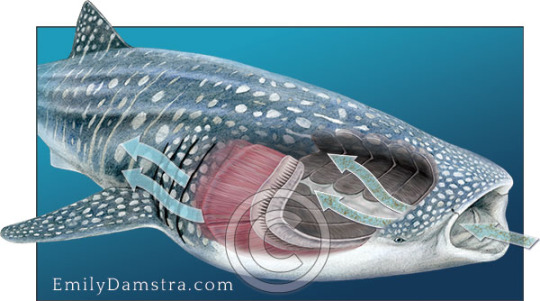
(Image: an artistic diagram of the feeding pads and gills of a whale shark and how water flows through the mouth and out the gills. Source: EmilyDamstra.com. End ID)
Whale sharks live in temperate and tropical oceans worldwide and can be found in both the open ocean and coastal regions. They are gentle giants who swim slowly and bask at the surface of the ocean, not threatening anything bigger than a sardine. While they spend a lot of time at the surface, whale sharks periodically dive in search of food. Most of these dives are less than 200 meters (660 ft) deep, but they will occasionally dive over 500 m (1,600 ft) deep. The deepest recorded dive reached 1,928 m (6,325 ft), the deepest recorded dive of any fish. Whale sharks are known to practice different feeding behavior based on available food in their region. There are two subpopulations of whale shark based on location: the Atlantic and Indo-Pacific populations. 75% of the whale shark population lives in the Indo-Pacific. Whale sharks seasonally migrate following warm waters and food and may also migrate to mate. Multiple places around the world host seasonal gatherings of whale shark, making them to best place to reliably see them.

(Image: a whale shark from the side, swimming with its mouth open. Other fish can be seen in the background. End ID)
Not much is known about Whale shark mating. It has only been seen a few times in Saint Helena Island in the Atlantic and off the coast of Australia. Mating likely occurs during the seasonal aggregations. Female whale sharks are believed to travel to regional pupping grounds to give birth, but where exactly these are is an open question as juvenile whale sharks are rarely seen. The youngest whale shark ever observed was discovered having been captured and tied to a stake on a beach in Pilar, the Philippines. It was measured at 38 cm (15 in) and was released after being measured. This discovery likely means there is a pupping ground in the area. Whale sharks are ovoviviparous, meaning their eggs hatch internally and the young are born live. Whale shark females are believed to be able to reserve sperm and impregnate themselves repeatedly between matings, rather than bearing all their young at once. It is not clear how long it takes whale sharks to mature or how long they can live, though some estimates put them at sexually mature at around 25 years old and with a maximum lifespan between 50 and 150 years. It is estimated that only 10% of whale sharks live long enough to reach sexual maturity. Adult whale sharks have no natural predators.

(Image: a baby whale shark that was rescued from a gill net in India. It looks like a smaller version of the adult, but with a proportionately larger head. A human (out of frame) is holding it just above the water. ENd ID)
Whale sharks are classified as endangered by the IUCN. They are threatened by fishing, poaching, bycatch, and boat strikes. Whale sharks are hunted for their skin, liver oil, and meat, though countries worldwide are increasingly regulating or banning whale shark hunting. Whale sharks also ingest large quantities of microplastics. The health effects of this are not understood currently. Whale sharks are kept in captivity in less than 20 aquariums worldwide. They need very large tanks and have special feeding requirements that makes it difficult to keep them healthy. Wild whale sharks pose no threat to humans though there have been reports of them ramming sport fishing boats after being provoked. In places where whale sharks seasonally aggregate, snorkeling or SCUBA diving alongside them has become a major ecotourism industry. Touching the sharks can hurt them and is illegal in most places. Some tourism agencies have been known to lure in young whale sharks by feeding them shrimp, something which is discouraged by naturalists as it can foster dependence on humans and potentially introduce dangerous chemicals to the sharks' diets.
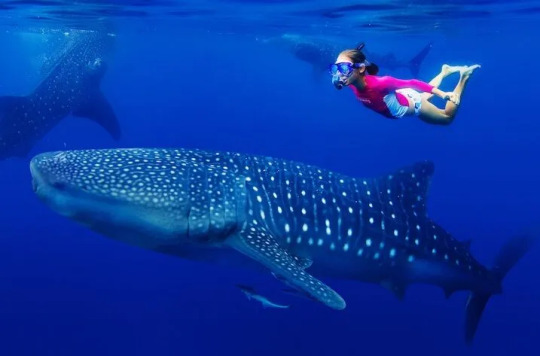
(Image: a person in a pink swimsuit wearing goggles and a snorkel swimming next to a whale shark just beneath the surface of the water. Two other whale sharks are in the background. End ID)
#wet beast wednesday#whale shark#shark#sharks#shark week#fish#fishblr#fishposting#carpet shark#marine biology#marine life#biology#ecology#zoology#animal facts#informative#educational#image described
168 notes
·
View notes
Text

Did you know that the lineage leading to geckos goes all the way back to the Jurassic? Geckos represent one of the oldest divergences of extant lizards, second only to the obscure Dibamids, with all other lizards (including snakes!) being more closely related to each other than to geckos. Fortunately for us, stem-geckos from the Mesozoic are well-represented in the fossil record. We likely already have one in-game, depending on your preferred taxonomic interpretation of the long-tailed lizard Schoenesmahl, which will be joined by an additional three: Ardeosaurus, Eichstaettisaurus, and Helioscopos.
Ardeosaurus is a small lizard known from the Late Jurassic of Germany. It has been found in the Altmühltal Formation, which represents the famous Solnhofen Archipelago environment, from which famous dinosaurs such as Compsognathus and Archaeopteryx hail. This would have been a tropical, insular setting, inhabited by many small reptiles such as this one. The taxonomic placement of Ardeosaurus and its nearest kin remains unsettled, with some papers placing it as a stem-skink, iguanian, or even a stem-squamate. However, it is most often recovered as a stem-gecko. Ardeosaurus is known from complete specimens and is around 20 cm long.
Eichstaettisaurus was originally described as a species of Ardeosaurus, before being separated out later. Like Ardeosaurus, this lizard is known from the Altmühltal Formation, however, in contrast, it is also known from Early Cretaceous fossils in Italy. Both preserve similar marine lagoonal environments, suggesting comparable habitat preferences across this entire period of time. Eichstaettisaurus is generally recovered closer to extant geckos than Ardeosaurus, which likely represents a slightly older branch in gecko evolution. No specimen of this lizard preserves the entire tail, but comparisons of the larger specimen with Ardeosaurus suggests a length around 15-20 cm. Helioscopos is an Ardeosaurid known from the other side of the world: the Morrison Formation of the western United States. It was described from a disarticulated skull near the end of 2023. The description of this taxon identified it as a stem-gecko and reinforced the identification of Ardeosaurus within this stem group as well. The presence of geckos in both Europe and North America is consistent with other shared fauna between these regions during this time. As a member of the Morrison fauna, it would have lived alongside many of the most famous dinosaurs, including Stegosaurus, Allosaurus, and Brachiosaurus. The name Helioscopos means “sun watcher,” a reference to the large pineal foramen, which likely indicates the presence of a parietal eye, a primitive light-sensing organ in the center of the skull. Assuming proportions similar to Ardeosaurus, Helioscopos was likely around 15 cm.
90 notes
·
View notes
Text

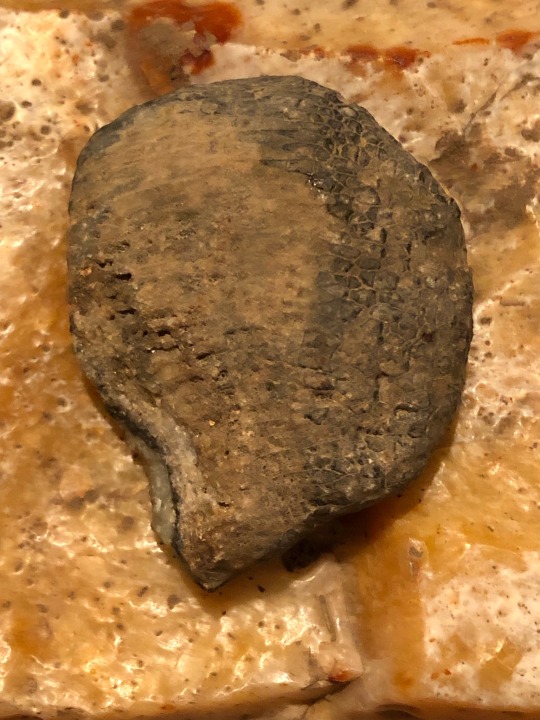

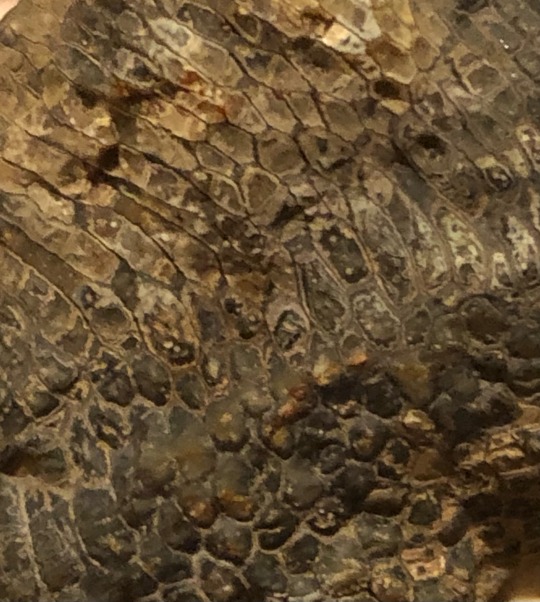
So again I need some suggestion help of the rock - fossil identification on this specimen.
It has the pattern like the chambers from modern „unions cells“ or, some piece of an petrified coral or sponge.
Dark grey non tranculent. Lightly weight.
Found on the yesterdays fossil hunt on the search with other rocks, flint shards from surrounding field works. Flat surface of rock, not polished to feel more like an rub over an tortoise shell. 🐢 But of course it’s isn’t.
In the zoom you can seen the struckture. Found on the same location of finds like the previous sponge and echinoids near field tracks. With lot of chert flint pebbles and chunks.
Has the form vaguely of an oyster shell but it isn’t one, has no cracks or rims like an shell struckture. More like an onion cell chambers, under an microscope.
Can’t tell which rock it is but likely with silicate parts.
The Google image search and reading of porifea or coral finds in forums doesn’t helped.
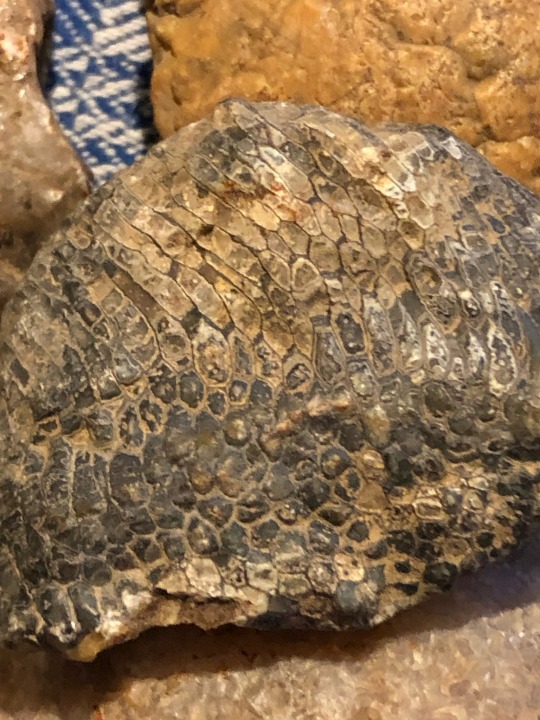
Posting it again. Have no idea suggesting part of an coral or likely sponge struckture petrified. Found on dry field land in the middle range of Germany, no direction to the sea or large rivers.
3 notes
·
View notes
Text
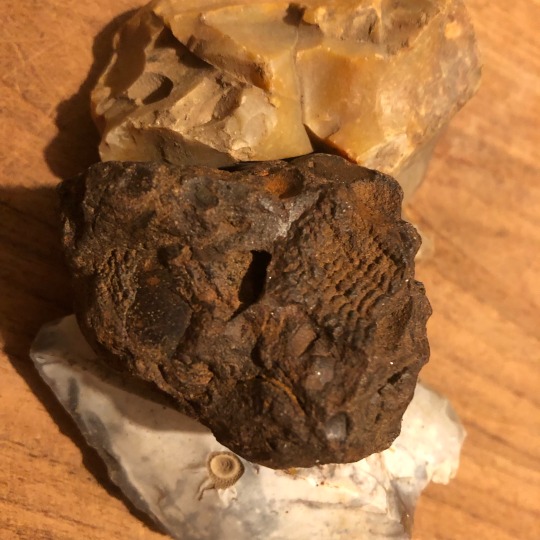
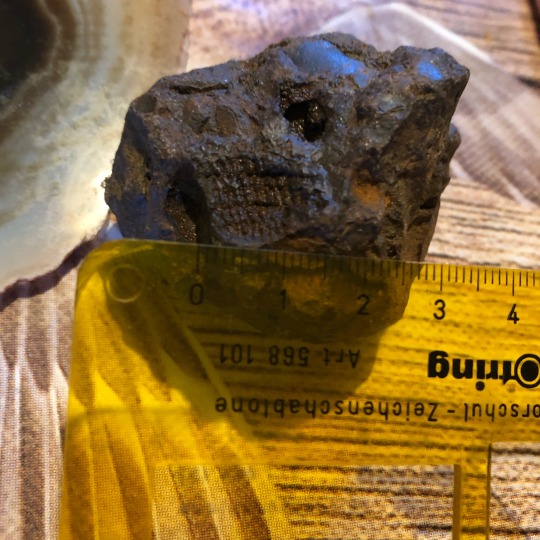


The last wednesday, i found the round urchin from before post, with this mold of an rare fossil in my area. I suggest it if, it is the case. 🔍👀
Absolutly rare to seen in the northern region of germany, myself not knowing these are also here to find.
I havent seen those before on the search for minor fossils and rocks on sand and land, without any local modern river or mountains in the near area.
Likely an trace fossil mold of an tiny trilobite, the form with an missing head piece probably are on the missing other side of the rock.
The rock is not flint, some other sediment stone in rusty brown color with little metallic spots held in light.
After washing, it retains moisture longer then other stones in drying.
The print mold has the size of an fingernail.
Identification where appreciate great to know of its an case for an trilobite family speciemen or some other suggestion what its belongs of pattern in rock.
It would be great to know & also for other rock fans with maybe have seen those pattern .
I know nothing about limestone or iron rock variations in my area, and seen not common these stones or fossils from them here myself.
Super lucky, and it does resembles the larger trilobite in contrast of an mold in the lining struckture.
#fossils#rocks#geology#fossil hunt#fossil collecting#fossil identification#fossil#trilobite#fossils in germany#fossils 2024
15 notes
·
View notes
Photo

Nummulites laengryus Fossil - Bracklesham Beds, Eocene - Bracklesham Bay, Sussex, UK - Genuine with COA
Nummulites laengryus Fossil - Bracklesham Beds, Eocene - Bracklesham Bay, Sussex, UK
This is a genuine fossil specimen of Nummulites laengryus, a species of Foraminifera, sourced from the Bracklesham Beds, Eocene period, Bracklesham Bay, Sussex, UK. Nummulites are single-celled marine organisms with distinctive, disk-shaped calcareous shells, which accumulated over millions of years to form vast limestone deposits. These fascinating microfossils played a crucial role in shaping ancient marine ecosystems and are of significant scientific interest.
Geological Information:
Species: Nummulites laengryus
Fossil Type: Foraminifera (Single-celled Marine Protist)
Age: Eocene (~56 to 33.9 million years ago)
Formation: Bracklesham Beds
Location: Bracklesham Bay, Sussex, UK
Preservation: Fossilized calcite shells embedded in sedimentary rock
About Nummulites: Nummulites are a type of foraminifera, microscopic marine protozoans that produce multi-chambered shells. These organisms thrived in warm, shallow seas and their abundant remains helped form limestone deposits, particularly in regions like the Bracklesham Beds and the famous Eocene Nummulitic Limestone of the Mediterranean.
Fossils of Nummulites provide valuable insights into paleoclimates, ancient marine ecosystems, and biostratigraphy, helping geologists date sedimentary rock layers.
Key Features:
100% genuine fossil specimen of Nummulites laengryus
Comes with a Certificate of Authenticity
Well-preserved fossil with visible spiral structure and calcite shell details
Sourced from the Bracklesham Beds, Eocene, a renowned fossiliferous site in the UK
A fascinating piece of geological and paleontological history
Ideal for collectors, geologists, paleontologists, and educators
Handling & Care:
Fragile Specimen: Handle with care to preserve its delicate structure.
Keep Dry: Store in a dry environment to prevent deterioration.
Cleaning Tip: Use a soft brush to remove any dust or debris. Avoid harsh chemicals or moisture exposure.
Additional Information:
The photos show the actual specimen you will receive, ensuring transparency and authenticity.
Scale cube = 1cm; for full sizing, please refer to the images provided.
Expertly packed for safe and secure shipping.
This Nummulites laengryus Fossil is a rare and scientifically significant specimen, perfect for anyone passionate about fossils, ancient marine life, or natural history. Buy with confidence, knowing you are receiving a 100% authentic fossil, backed by our Certificate of Authenticity.
🛒 Add this remarkable Nummulites Fossil to your collection today!
#Nummulites Fossil#Foraminifera Fossil#Eocene Fossil#Bracklesham Bay Fossil#Sussex Fossils#Bracklesham Beds#UK Fossils#Microfossil#Fossilized Shell#Paleozoic Fossil#Fossil Collector#Geological Specimen#Authentic Fossil#Ancient Marine Life#Fossil Identification#Rare Fossil#Scientific Fossil#Fossil Display#Natural History Collectible
0 notes
Text
An interesting fact about the discovery of mammoths, which were some of the first ever fossil animals to be excavated, like, ever is that, despite tusks from frozen mammoth remains being known about and even commercialized in Western Europe since about the early 17th century and the fact that Europeans had a decent idea of what elephants were since like, antiquity, they wouldn’t really make the connection between mammoths and elephants until the 1720s.
One of the first correct identifications was made by the still-enslaved inhabitants of colonial America of African origin. A mammoth molar was unearthed in South Carolina and, while the white land owners were puzzled by it, the African community of the area unanimously agreed that it belonged to an Elephant-like animal due to its resemblance to the dentition of African elephants. They would later be backed up by a British naturalist who traveled all the way to the US to study the tooth.
30 notes
·
View notes
Text


fat baby hand spotted on the fossil identification subreddit
39 notes
·
View notes